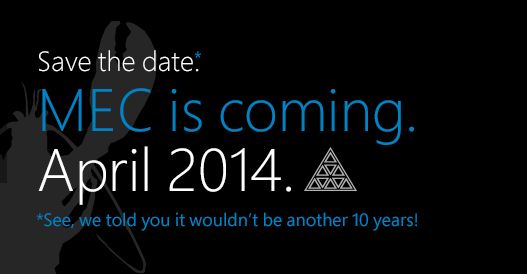Microsoft has announced that the next MEC (Microsoft Exchange Community) conference will be held in April 2014 at a yet to be disclosed location.

The timing is interesting (to me at least) in that it is about 18 months after the last MEC, which was held in Orlando in late September 2012, and almost 2 years after the Exchange 2013 Preview was released.
Considering the new Exchange 2013 servicing model with the 3 month “cumulative update” release cycle I would imagine we’ll be seeing quite an evolution in the product by the time April 2014 rolls around. This may mean that Microsoft has a lot of new and exciting features to present to the community.
Another theory is that a whole new “version” of Exchange will be released around that time. This was flagged in a comment on Tony Redmond’s Exchange Unwashed column regarding MEC:
Sounds like a Wave 16 release party to me. Being that the Lync/Skype team announced a new server version around the same time frame.
That is based on a blog post by Tony Bates, the President of the Skype Division at Microsoft:
Lync Online updates will be delivered quarterly to enable rapid customer adoption, and we will release a new Lync server version in Q2 of 2014.
The “Office Wave 15” products all launched together so it seems reasonable to expect the same from the next wave too.
Supporting that theory is the general shift in Microsoft’s product development strategy to more frequent refreshes and updates. When I read about code name “Blue”, the new Exchange servicing model, and the pace of updates to Microsoft’s Office 365 service it seems entirely possible that they all line up as part of an overall Microsoft strategy.
But why would Microsoft want to shake everything up and go from big releases every 3-4 years to more frequent cumulative updates and a shorter support life cycle? I can think of a few reasons.
- Subscription services bring in a steadier, more predictable revenue stream than big product launches.
- Subscription customers want to see new features and improvements more often to justify paying monthly rather than an one-time investment in software they can use for years to come.
- The engineering effort required to develop completely separate on-premise and online code is too great, so the on-premise customers have to ride along with the pace of change in the cloud.
- The “every second version” upgrade cycle many customers stick to is both a revenue and support issue for Microsoft when those versions are released years apart.
- Too many customers sit on legacy versions for too long (“…there is a good amount of our Exchange customers who are still transitioning off Exchange 2003…” – MS Exchange Team blog, November 2012).
So what do I think we’ll see at MEC 2014?
- News of Exchange vNext and some technical sessions to about the same level as were delivered for Exchange 2013 at TechEd Australia 2012 and MEC 2012.
- Lots of Hybrid/Office 365 content for Exchange 2013 and vNext scenarios (the cloud story is only going to get stronger).
- Much deeper content about Exchange 2013 than what is available today, thanks to a full year of CU releases and greater “real world” experience to draw upon.
That seems like it would make for a great conference and I’m certainly interested in attending.
Hopefully we’ll see more information soon about the exact dates and location for MEC 2014. Personally I think Microsoft should consider bringing the event down under to Australia. Surely all you northern hemisphere IT pros get tired of travelling to the same old cities for conferences, and would love to go international for a change, right? 🙂



Pingback: The UC Architects » Episode 18: Get Us Drunk, and We’re Yours!